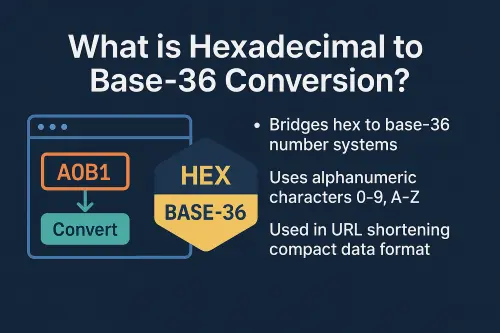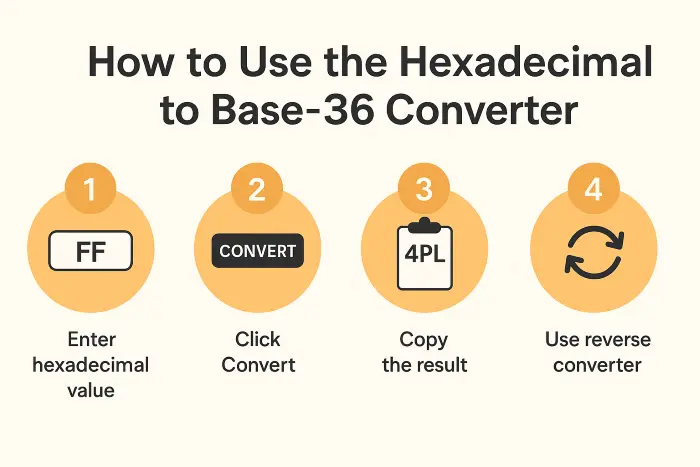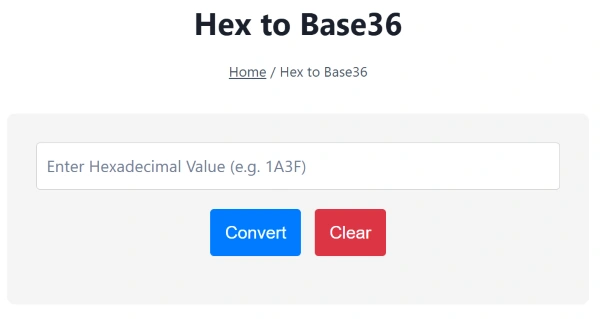Hex to Base36
Reverse Conversion Tool: Base36 to Hex Converter
What is Hexadecimal to Base-36 Conversion?

Understanding hexadecimal to base-36 conversion requires familiarity with different number systems. While the hex to decimal converter helps bridge the gap between hexadecimal and our familiar base-10 system, converting directly to base-36 offers unique advantages in specific applications like URL shortening and compact data representation.
The hexadecimal system uses 16 symbols (0-9, A-F), while base-36 extends this concept further by utilizing all 36 alphanumeric characters (0-9, A-Z). This conversion is particularly useful when you need to represent large numbers in a more compact format than what traditional binary to hex conversion or decimal to hex conversion can provide.
How to Use the Hexadecimal to Base-36 Converter?

Our intuitive converter makes it simple to transform hex values into base-36 format:
- Enter your hexadecimal value in the input field (e.g., FF, A0B1, 1234)
- Click Convert or watch the real-time conversion
- Copy the base-36 result for use in your projects
- Use the reverse converter to go from base-36 back to hexadecimal
The tool supports various input formats including whole numbers, large values, and validates your input to ensure accurate conversions every time.
The hex to base36 converter image is shown below:

Understanding Number Systems
When working with hexadecimal to base-36 conversion, it’s essential to understand how different bases relate to each other. Just as hex to octal conversion demonstrates the relationship between base-16 and base-8 systems, base-36 conversion shows how we can extend beyond traditional computing bases.
Hexadecimal System (Base-16)
- Uses digits: 0, 1, 2, 3, 4, 5, 6, 7, 8, 9, A, B, C, D, E, F
- Each position represents a power of 16
- Commonly used in programming and hexadecimal calculator applications
Base-36 System
- Uses characters: 0-9 and A-Z (36 total symbols)
- Each position represents a power of 36
- Maximum base using standard alphanumeric characters
- Ideal for creating compact, human-readable identifiers
Practical Applications of Base-36 Conversion
The base-36 system represents the maximum base using standard alphanumeric characters, making it ideal for applications where you need human-readable compact representations of large numbers:
Web Development
- URL Shortening: Services like bit.ly use base-36 for compact URLs
- Session IDs: Generate shorter, more manageable session identifiers
- Database Keys: Create readable primary keys and reference numbers
Software Development
- License Key Generation: Produce user-friendly software licenses
- Hash Representation: Display hash values in compact format
- Version Control: Create shorter commit identifiers and branch names
Data Processing
- File Naming: Generate unique, sortable filenames
- Timestamp Encoding: Compress datetime values for storage efficiency
- ID Generation: Create sequential identifiers with minimal character count
Advanced Conversion Features
Bidirectional Conversion
Our tool supports both directions of conversion, similar to other tools in our suite:
- Hexadecimal to Base-36 conversion
- Base-36 to Hexadecimal conversion
- Real-time validation and error checking
- Support for large number processing
Multiple Input Formats
The converter handles various input scenarios:
- Standard hex notation (e.g., A1B2)
- Prefixed hex values (0xA1B2)
- Uppercase and lowercase letters
- Mixed case input with automatic normalization
Related Number System Tools
For comprehensive number system work, users often need multiple conversion types. Our complete toolkit includes:
Essential Hex Conversions
- Hex to Binary – Convert to binary for bitwise operations
- Binary to Hex – Transform binary data to hex format
- Hex to Decimal – Standard base-10 conversion
- Decimal to Hex – Convert decimal numbers to hex
Specialized Conversions
- Hex to ASCII – Text encoding applications
- ASCII to Hex – Reverse text processing
- Hex to Base 64 – Web-safe encoding
- Base 64 to Hex – Decoding operations
- Base 12 to Hex – Base conversion logic
Network and System Tools
Network administrators and developers often combine base-36 conversion with other specialized tools:
- Hex to IP – Network address conversion
- IP to Hex – IP address manipulation
- Octal to Hex – Legacy system compatibility
Mathematical Operations in Different Bases
Similar to the comprehensive hexadecimal calculator that supports arithmetic operations, understanding base-36 mathematics opens up advanced calculation possibilities. Whether you’re performing hexadecimal addition, hexadecimal subtraction, or exploring modular base-36 arithmetic, these operations are essential in cryptographic algorithms, custom encoding systems, and data compression workflows.
Base-36 Arithmetic
- Addition and subtraction using alphanumeric digits
- Multiplication with carry-over handling
- Division with remainder calculations
- Modular arithmetic for cryptographic applications
Conversion Accuracy
Our algorithms ensure precise conversion by:
- Using exact mathematical formulas
- Handling large numbers without precision loss
- Validating input and output formats
- Providing consistent results across all operations
Technical Implementation Details
Conversion Algorithm
The hexadecimal to base-36 conversion follows these steps:
- Parse Input: Validate and normalize hex input
- Convert to Decimal: Transform hex to base-10 intermediate
- Base-36 Encoding: Apply base-36 digit mapping
- Format Output: Present result in standard base-36 notation
Error Handling
- Invalid character detection
- Range validation for large numbers
- Format correction suggestions
- Clear error messaging
Best Practices for Base-36 Usage
When to Use Base-36
- Creating compact identifiers
- URL shortening applications
- Database key generation
- Hash value representation
- Time-based encoding systems
When to Use Other Bases
- Binary: Low-level programming and bitwise operations
- Octal: Legacy system compatibility
- Decimal: Standard mathematical calculations
- Hexadecimal: Memory addresses and color codes
Frequently Asked Questions About Hex to Base36 Converter
Q1: What is the difference between hexadecimal and base-36?
A1: Hexadecimal uses 16 symbols (0-9, A-F) while base-36 uses 36 symbols (0-9, A-Z). Base-36 provides more compact representation for large numbers but requires more complex conversion algorithms.
Q2: Can I convert negative hexadecimal numbers?
A2: Yes, our converter handles negative values by preserving the sign during conversion. The negative symbol is maintained in the base-36 output.
Q3: What’s the maximum hex value I can convert?
A3: Our converter supports very large hexadecimal values, limited primarily by browser memory constraints rather than the conversion algorithm itself.
Q4: How accurate is the conversion?
A4: The conversion uses exact mathematical algorithms ensuring 100% accuracy for all valid inputs within the supported range.
Q5: Why would I use base-36 instead of hexadecimal?
A5: Base-36 provides more compact representation than hex for large numbers and uses only standard alphanumeric characters, making it ideal for systems requiring human-readable identifiers.
